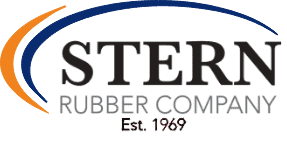WHAT IS RUBBER TO SUBSTRATE BONDING?
Vulcanized bonding of rubber to substrate is a generic phrase that covers all aspects of the process by which an elastomer is chemically bonded to a pre-coated steel surface. Substrate Bonding rubber to substrate is useful for products the require the strength of steel and the flexibility of rubber.
Bonding references to the process of chemical adhesion of rubber to a substrate. Substrates vary from Nylon and other plastics, to various types of ferrous and non-ferrous metals, to even Teflon. Bonding rubber to a substrate is useful for products that require extra strength or rigidity that rubber alone could not provide.
The vulcanization of the bond occurs simultaneously with the cure of the elastomer, as bonding agents are designed specifically to react with the rubber processing conditions. Maximum bond strength is obtained under pressure in compression, injection, or transfer molds.
At Stern Rubber Company we specialize in over molding and bonding of rubber to other substrates. We can bond to aluminum, steel, iron or aluminum castings, plastics, cables, cords such as nylon, rayon, or Kevlar, and even other rubber. We have even bonded rubber to Teflon!
Stern Rubber Company uses a proprietary metal treatment processes to prepare the substrates for the bonding agent. The bonding agent is applied by spraying, dipping, or by hand, and includes stringent process controls that monitor the film thickness of the bonding agent from one part geometry to the next.
Get started today!
Or call 218.894.3898
